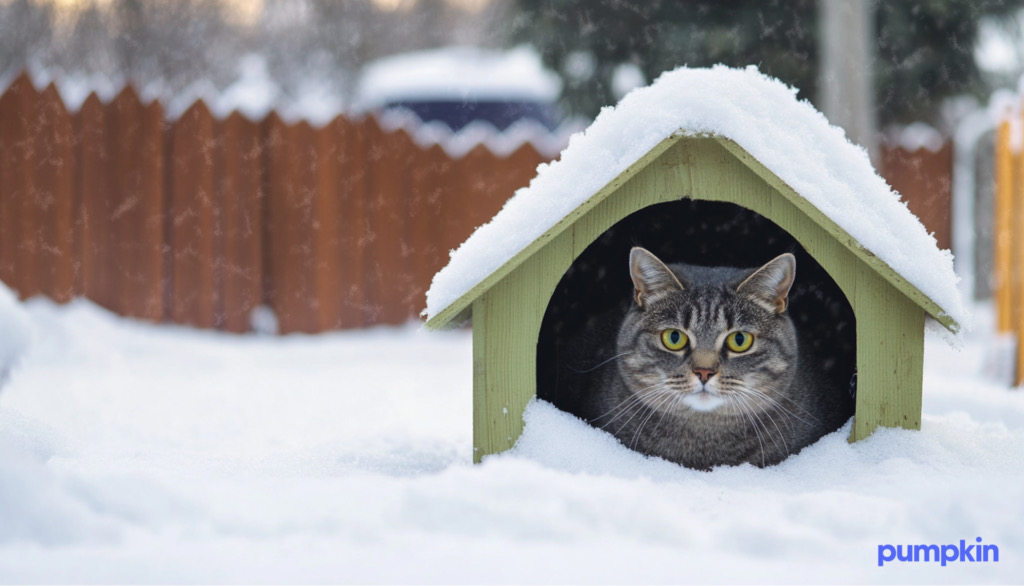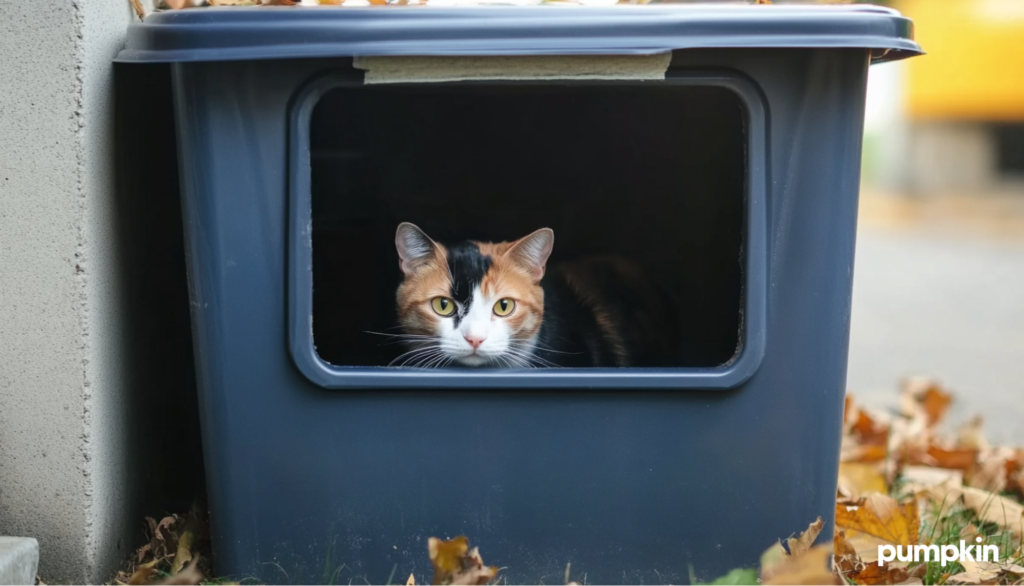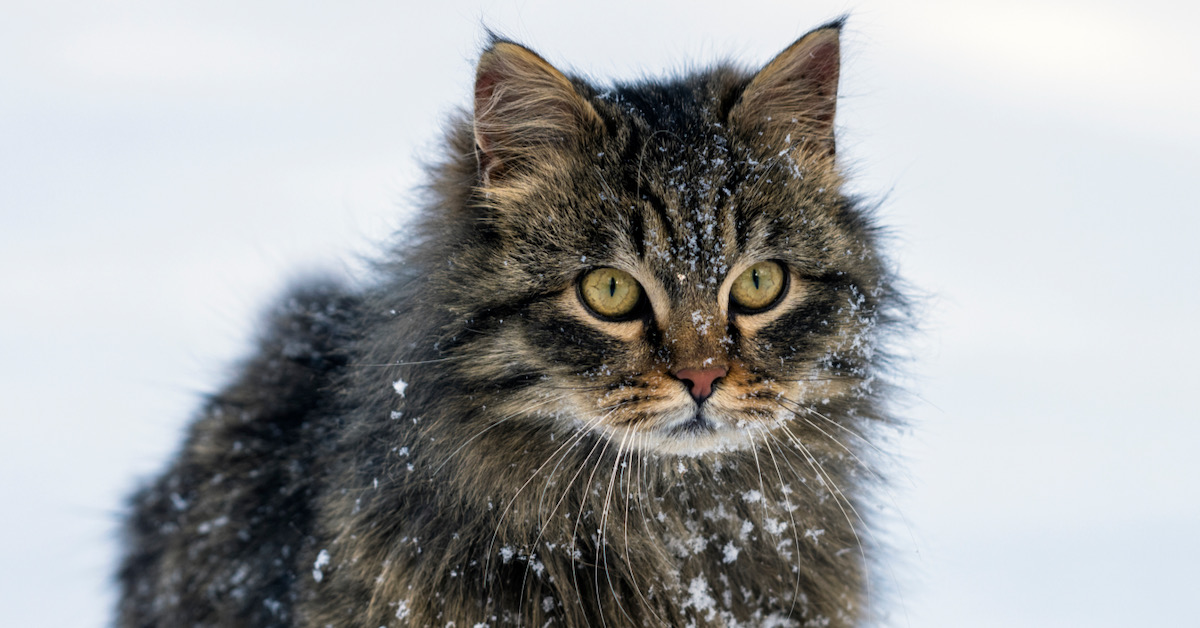Key Points
- Outdoor cats can adapt to the cold, but they may still struggle to stay warm in winter.
- A pre-made or DIY outdoor cat shelter could be life-saving for stray and feral cats during winter.
- Insulation, proper sizing, elevation, weatherproofing, and placement are key for an effective cat shelter.
When winter throws its worst at stray and feral cats, it’s heartbreaking to see them struggle. If you could, you’d open your doors to every shivering cat. Unfortunately, our hearts are often bigger than our homes.
But that doesn’t mean you can’t do anything to help. Providing outdoor cat shelters for winter is an act of kindness that could make a huge difference. Whether you’re interested in building DIY outdoor cat shelters or simply want to help your beloved housecat stay warm when they’re outside, we’ve collected some tips for creating safe spaces.
How do outdoor cats adapt to winter?
Outdoor cats are savvy when it comes to dealing with the cold. They sport thick coats, which grow even thicker in the winter for better insulation.
Just like you snuggle under the covers on a cold night, cats instinctively seek out warm, sheltered spots for protection against the cold. You might find stray and feral cats living under porches or in sheds during the winter.
Cats also become less active in cold weather to conserve energy and stay warm. But even so, when the temperature drops, outdoor cats can still get cold and require extra protection.
Winter cat shelters help strays survive
Even the most basic outdoor winter shelter for cats can help them stay warm, dry, and safe. Shelters let them raise their body temperature significantly, preventing hypothermia and frostbite and increasing their chances of survival.
However, it’s also important to be realistic. You can’t guarantee the safety of every stray cat you meet, unfortunately. Ultimately, without a human to care for them, some cats will succumb to cold weather exposure. It’s the circle of life — and another reminder of the importance of spaying and neutering our pets.
Still, a good outdoor cat shelter for winter offers more than just physical warmth. It provides a sense of security, a cozy spot to rest, and a break from the harsh realities of outdoor life.
What to consider when building a cat shelter
Want to build a cat shelter that truly helps stray cats? Here’s what you need to know:
Insulation
You want to create a space where cats can truly nest and stay warm — insulation is a big part of that. Most experts recommend lining the shelter with straw (but not hay, which can mold) for effective insulation. Keep in mind that the materials you use need to be dry and loose so cats can burrow inside to stay warm.
Don’t use folded newspaper, regular blankets, or towels because cats can only lay on them, which actually draws their body heat away from them. Mylar blankets work well because they reflect body heat (they’re also cost-effective).
For extra insulation, consider lining the walls and roof of your shelter with Styrofoam insulation boards.
Proper size
Your winter cat shelter should be large enough for a cat to turn comfortably, but not so large that it loses heat quickly.
Aim for a minimum size of about 12″ x 18″ x 12″ to fit a single cat, or 24″ x 24″ x 18″ for a few cats — more cats mean more body heat to keep each other warm.
Elevation
A soggy cat shelter defeats the purpose. Take an extra few minutes to elevate the shelter off the ground to prevent moisture from seeping inside.
Raise the shelter a few inches (roughly 6 inches) using bricks, wooden pallets, or anything sturdy you have on hand. At a minimum, place a wooden board between the ground and the shelter. This ensures your cat shelter stays cozy and comfortable for your kitty tenant.

Weatherproofing
If you’re building a DIY cat shelter, make sure it can handle anything Mother Nature throws its way. Start by waterproofing the cat shelter by using a durable, water-resistant material for the exterior, such as a plastic storage bin or corrugated plastic roofing sheets.
A sloped roof can also prevent heavy rain, wind, and snowfall from accumulating and damaging the shelter. Remember to seal any cracks or gaps in the shelter with caulk to block drafts.
Strategic placement
When placing your sturdy winter cat shelter, consider a cat’s instincts. Cats tend to feel safer in hidden spots where they can observe without being seen. So, place the cat house in a quiet area that’s out of sight and blends into the surroundings.
If dogs or other animals are a threat, keep the shelter somewhere they can’t access, like under a porch, in a shed, or behind a fence. The location should be at least semi-sheltered from the elements.
It’s also a good idea to face the shelter doorway away from the wind to prevent cold drafts from blowing directly into the shelter.
Protection from predators
Let’s face reality — raccoons may try to take over your outdoor cat house. They may even succeed.
Keep your shelter cats-only by making the entrance hole smaller. Don’t worry, cats can squeeze into small openings as long as their heads fit. Generally, the entrance should be around 5 or 6 inches in diameter.
An awning that covers the entrance can also help keep unwanted critters out while providing extra protection from rain and snow. These can be easily added using materials like rolled plastic or garbage bags.
Maintaining cleanliness
Your outdoor cat shelter needs to be cleaned regularly to prevent the buildup of dirt, debris, and parasites. A clean shelter keeps the cat healthy and comfortable and stops it from becoming a breeding ground for pests.
Regularly replace the bedding materials, especially if they become damp or soiled. You should also disinfect the shelter periodically with a pet-safe disinfectant.
DIY outdoor cat shelters you can build
Ready to channel your inner architect and build a cat shelter that’s the talk among the local neighborhood cats? Try these three easy outdoor cat shelters for winter DIY projects:
The simple styrofoam den
Materials: Large styrofoam cooler, box cutter, straw, and waterproof tape (optional)
Upcycling a styrofoam cooler is one of the easiest ways to make an effective DIY cat shelter, as seen on TikTok. It’s a lightweight option that has heavy-duty insulation.
First, cut a hole into an old styrofoam box or cooler and line the interior with straw or other insulating materials. Then, reinforce the entrance with waterproof tape. Voilà! You’ve got yourself a cat shelter in 10 minutes.
Styrofoam dens are affordable and easy to make, though they might be less durable and can attract chewing rodents.
The classic storage bin shelter
Materials: Two plastic storage bins (one slightly smaller than the other), box cutter, waterproof tape, straw, and styrofoam insulation (optional)
Put those storage bins that have been lying around to good use. This is another cost-effective and simple DIY cat shelter that’s also durable. Using two bins you can create an insulated cat cave for your feline friend.
Cut a cat-sized entrance in both bins and place the smaller bin inside the larger one. Line the space between the bins with straw or styrofoam for extra insulation (add straw inside the smaller bin too).

The sturdy wooden house
Materials: Wood planks or plywood, screws, screwdriver, saw, power tools (optional) straw or other insulation materials, waterproof roofing material (optional), and hinges (optional)
If you’re feeling extra ambitious and are good with your hands, you can build a custom wooden cat condo for your community cats. Your wooden cat house doesn’t have to be super elaborate; a simple wooden cat house with hinges would do the trick. Or get a little fancy with this wooden DIY cat shelter.
Pre-made outdoor cat shelters
Short on time or DIY skills? There are many great pre-made cat houses. Consider the following options to help out a kitty in the winter:
While they might be a bit pricier than DIY options, they offer convenience and sometimes come with extra features.
*This cat house was personally recommended by the aunt of a Pumpkin team member (shoutout to Aunt Rita!), who says she loves this affordable heated cat shelter from Amazon.

Every bit of warmth counts
You can’t always change the world, but you can sometimes change a cat’s world. An outdoor cat house can mean the difference between life and death during the harsh winter months. In the worst-case scenario, you’ll make one lucky raccoon really happy.
But it’s important to be realistic. Feral cats are faced with many challenges, including health issues, parasites, territorial disputes, and competition for resources. Even the best shelter can’t guarantee their safety or solve all their problems.
That’s why it’s important to support Trap-Neuter-Return (TNR) efforts in your community to humanely manage feral cat populations and improve their quality of life.
Ultimately, cats are domesticated animals that need a human to live a full, healthy life. Learn more about how Pumpkin Cat Insurance plans can help protect your feline friend as they grow up.
FAQs
- https://www.cats.org.uk/cats-blog/do-cats-eat-more-in-winter
- https://www.cats.org.uk/cats-blog/do-cats-sleep-more-in-winter
- https://feralcatfocus.org/colony-management-shelters
- https://www.bideawee.org/programs/feral-cat-initiative/colony-care/food-and-shelter/shelters/
- https://homeandroost.co.uk/blogs/cats/how-to-place-an-outdoor-cat-shelter
- https://felinebehaviorsolutions.com/cats-love-hiding/
- https://feralcatsadvocacy.org/tnr
- https://www.diamondpet.com/blog/health/safety/caring-outdoor-cats-cold-weather
DISCLOSURE
Disclosure: This post contains affiliate links at no additional cost to you. We may earn commissions from Amazon or other vendors through these links. As an Amazon Associate, Pumpkin earns commissions from qualifying purchases.




